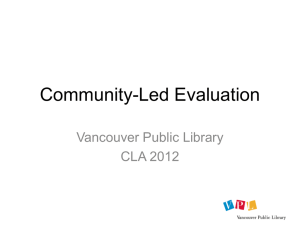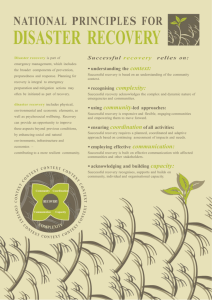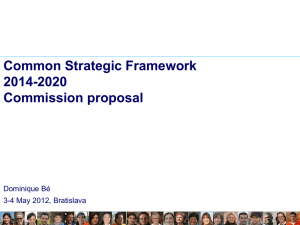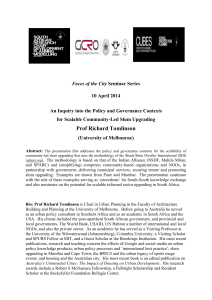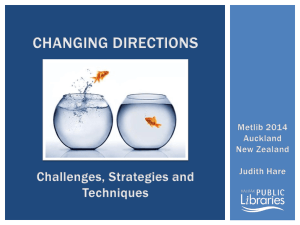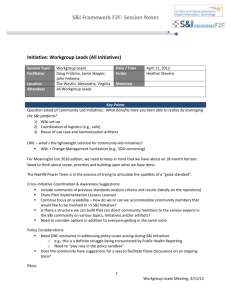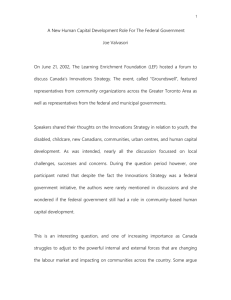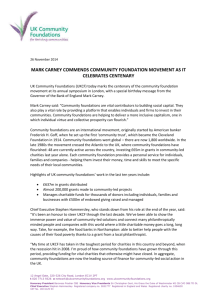Community-led Development - Department of Internal Affairs
advertisement
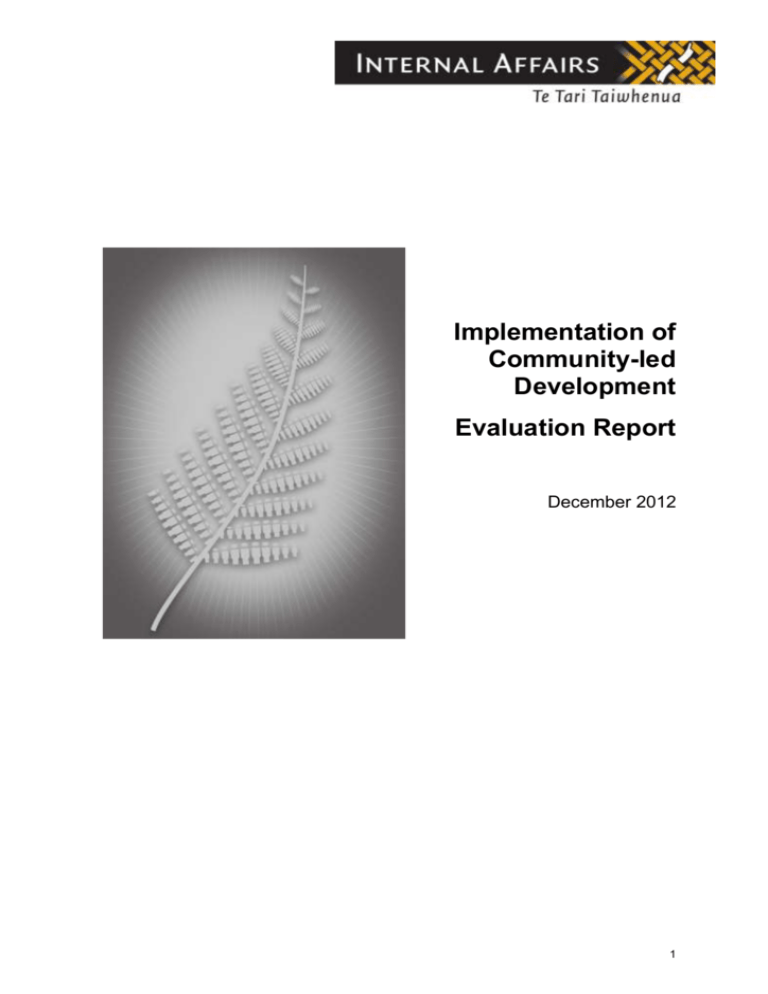
Implementation of Community-led Development Evaluation Report December 2012 1 Table of Contents Executive summary Introduction Purpose of the evaluation Methodology Results Conclusion Recommendations 1 1 1 1 2 3 3 Introduction Purpose of the evaluation Background Methodology 4 4 5 6 Results Question 1: How well did the Department perform in the implementation of community-led development? Question 2: What lessons were learnt about the Department’s programme management, resources and personnel? Question 3: What could make the initiative more effective and efficient? Question 4: Does the data support the theory of change? What explains its impact? 9 11 14 15 Conclusion 16 Recommendations 16 Appendices Appendix 1: Definition of community-led development Appendix 2: Definition of action research Appendix 3: Community-led development outcomes framework Appendix 4: Data collection methods Appendix 5: Quarterly Reflection Report questions Appendix 6: Focus Group Questions Appendix 7: Project governance and management 17 17 18 19 20 22 23 24 9 List of Figures Figure 1: Action research data sources for the community-led development evaluation 7 List of Tables Table 1: Funding allocation for community-led development Table 2: Summary of other performance data Table 3: Selection criteria for community-led development Table 4: Distribution of funding across wellbeing and funding types 5 10 11 13 2 Executive summary Introduction The Department of Internal Affairs (the Department) is responsible for supporting the outcome that New Zealand’s diverse people and communities, hapū and iwi are resilient and prosperous. In 2009 a review of the Department’s Crown funded schemes identified that a community-led development approach may be more effective in supporting this outcome. In 2011 the Department transferred funding from the Community Organisation Grant Scheme (COGS) to support a trial of a community-led development approach. This approach involves communities taking the lead in identifying their aspirations and goals and being resourced to implement the local actions needed. The five communities selected to take part in the trial were: Whirinaki, South Hokianga, Mt Roskill, Auckland, Mangakino, Waikato, Waitangirua / Cannons Creek, Porirua, and North East Valley, Dunedin. The trial, to be conducted from 2011/12 to 2014/15, will enable the Department to assess whether the community-led development approach achieves sustainable outcomes for communities, hapū and iwi. Purpose of the evaluation This evaluation assesses the implementation of the trial from 1 July 2011 to 31 August 2012. The report covers implementation, lessons learnt, and the improvements that could be made to make the trial more effective and efficient. At this stage, it is too early to report on the outcomes achieved by the community-led development approach or how it compares with other funding interventions. Methodology The Department is conducting the overall evaluation of community-led development based on the principles of action research. Action research involves working through cycles of planning, action, observation and reflection to draw out learning that supports continuous improvement. Data was collected for the evaluation at each stage of the action research cycle, as illustrated in the diagram below. 1 Results How well did the Department perform in the implementation of community-led development? Communities are accessing flexible funding that spans all the elements of community wellbeing and is not restrictive in terms of what activities and projects can be funded. The Department has, despite some challenges, successfully commenced the community-led development trial and ensured that the majority of milestones were met. Local processes of engagement and consultation are being community-led. The Steering Group and project team are implementing strategies to provide improved support, advice and resources to regional teams and the communities during the second year of implementation. What lessons were learnt about the Department’s programme management, resources and personnel? New learnings have come from sharing information and reflections across the whole team. More investment in professional development for staff is needed, for example, in project management. National office project team visits to communities throughout the process are critical. Staff need sufficient information on community-led development and community processes to support the trial. Clear and consistent information on milestones and expectations is needed. What could make the initiative more effective and efficient? As a new initiative, some aspects did not work as well as planned. The following would have improved the effectiveness and efficiency of the trial: implementing agreed processes in all communities, providing more formal staff training and development activities to address skills gaps, providing clear communication about the nature of community-led development, and the roles and responsibilities of both staff and community members, and establishing consistent expectations about milestones, deliverables, guidance and templates with staff and community members. The community leadership groups also pointed to the following areas where improvements could have been made: communication within the leadership group to establish working relationships, to develop a shared vision and to establish a common understanding of communityled development, additional engagement strategies to connect with ‘hard to reach’ members of the community to ensure full community participation, and communication with the Department about the work required to gain approval for the community plan and funding proposal, and consistency in advice from the Department. Does the data support the theory of change? What explains its impact? It is too early to identify the community outcomes achieved by the community-led development approach. 2 Conclusion The Department implemented community-led development in the five selected communities, starting on 1 July 2011. By 30 June 2012, almost all year one key milestones had been delivered in all five communities. However, there are learnings the Department should take on board following the implementation of the community-led development trial. Investment in staff development and training is critical when introducing a new initiative. Similarly, clear lines of communication are essential in making new initiatives work for participating communities. Providing staff and community members with clear project management principles and tools would have made the implementation more effective and efficient. The five communities now have access to the support and resources needed to build on local strengths and implement locally defined solutions to local issues. It will take some time before the impact of the approach is evident in changes to community wellbeing. Recommendations The recommendations focus on what the Department has learnt from the community-led development trial and what aspects of the initiative could be more effective. They are provided for the Department’s consideration. 1. The Department ensures its processes for working with communities are consistent with, and support, the principles and practices of community-led development. 2. The Department provides consistent advice and templates to leadership groups and regional teams, and addresses the identified skills gaps of staff through training and development activities. 3. The Department ensures that decisions are well documented and supporting material is recorded. 4. The Department proactively monitors implementation and manages any identified variation in agreed processes through regular meetings between the project team and regional offices. 3 Introduction The Department of Internal Affairs (the Department) is responsible for supporting the outcome that New Zealand’s diverse people and communities, hapū and iwi are resilient and prosperous. To support this outcome, the Department works with local communities through the provision of community development advisory services and administers a range of community grants schemes. In 2009/10, the Department undertook a review of the Crown funded schemes it administers. The review found that while these schemes were successful in terms of helping organisations and projects, it may be more effective to make intensive and longer-term investments in community development processes that are community driven and address the underlying causes of issues. This alternative approach is known as community-led development. Community-led development gives communities control of their development process. It involves the whole community – including business organisations, iwi Māori, neighbourhoods, local and central government agencies working in the community, and nongovernment organisations. It takes a holistic approach, meaning that it is not sector or project specific. To support a trial of community-led development, the Department received a transfer of funding from the Community Organisation Grant Scheme (COGS) to the Community Development Scheme. The transfer was intended to support a four-year trial of communityled development in four communities. A fifth community was included when additional funding was transferred to support the trial. The communities selected to take part in the trial were: Whirinaki, South Hokianga, Mt Roskill, Auckland, Mangakino, Waikato, Waitangirua / Cannons Creek, Porirua, and North East Valley, Dunedin. Alongside the implementation of community-led development, an evaluation is being conducted to assess implementation of the approach and, in the longer term, to identify what outcomes were achieved. Purpose of the evaluation The Department is conducting a four-year community-led development trial. Alongside implementation an evaluation is being conducted based on the principles of action research to assess both the implementation and impact of the initiative in the participating five communities.1 This report presents an evaluation of the implementation of community-led development for the period 1 July 2011 to 31 August 2012. The key questions that this report aims to answer are: 1 How well did the Department perform in the implementation of community-led development? What lessons were learnt about the Department’s programme management, resources and personnel? What could make the initiative more effective and efficient? Does the data support the theory of change? What explains its impact? Department of Internal Affairs (2011), Community-led Development Monitoring and Evaluation Framework. 4 As both the implementation and evaluation of the trial are in their early stages, this report is focused on the process of implementation. A summative (outcome) assessment is planned for December 2014. Background A community-led development approach is based on the following attributes: has a community-wide focus, rather than being sector or programme centred, involves members of the local community, people in communities decide and implement their own development priorities, and directs investments in communities in a strategic and outcomes focused manner. Refer to Appendix 1 for the Department’s full definition of community-led development. Table 1 below shows the funding allocated to support the community-led development initiative. The Minister for the Community and Voluntary Sector sought Cabinet approval to transfer $1.5 million per year from COGS to support an initial implementation of communityled development in four communities. The proposed transfer was for the four year period 2011/12 to 2014/15. In 2009, $1.2 million was allocated for community capability building over three years. The final year of this funding ($400,000) was reprioritised to support the community-led development in 2011/12, as it aligned with the coordinated focus on building sustainable community capability. The additional funding enabled the inclusion of a fifth community. In total $6.4 million was allocated for community-led development over four years. Table 1: Funding allocation for community-led development Amount allocated 2011/12 2012/13 2013/14 2014/15 $1.9 million $1.5 million $1.5 million $1.5 million The funding allocated for community-led development was to be directed to communities to focus on the local social, economic, cultural and environmental development. All internal costs, such as the provision of local advice and support2, project management, staff training and development, and the evaluation were met within the Department’s existing baseline operating budget. Based on the selection criteria and process approved by the Steering Group, the communities selected for community-led development were: Whirinaki, South Hokianga, Mt Roskill, Auckland, Mangakino, Waikato, Waitangirua / Cannons Creek, Porirua, and North East Valley, Dunedin. These communities were identified as having a readiness to participate and presented opportunities to include harder to reach groups that could be encouraged to participate in the community-led development trial.3 2 The Department of Internal Affairs has 16 regional offices located around New Zealand that provide community development advisory services. Each regional office consists of a team of Community Development and Funding Advisors and is supported by a Manager Regional Services. Cabinet Paper “Reprioritising COGS Funding to Support Community-led Development” SOC(11)6 defined harder-to-reach communities as those that have traditionally found it difficult to engage with government, including Māori, Pacific, ethnic and rural communities, and people with disabilities. 3 5 Methodology The four-year evaluation of the community-led development trial is based on the principles of action research. Action research involves working through cycles of planning, action, observation and reflection to draw out learning that supports continuous improvement (refer to Appendix 2). The Department has encouraged the participation of each community leadership group in action research, as the learning they gain can be a valuable resource for their ongoing work at the local level. Since 1 July 2011, the Department has collected information on the community-led development initiative in each of the five communities to enable an assessment of progress and the impact of the trial. To assist with data collection and analysis, an outcomes framework has been developed (refer to Appendix 3). The framework articulates how community-led development is expected to contribute to the Department’s high-level goal of supporting strong, sustainable communities, hapū and iwi. The framework identifies the immediate impacts of the community-led development approach on community aspirations and leadership, including that: information is available for decision making, aspirations are defined, community, hapū and iwi communication channels are open and operating, partnerships and collaborations have emerged, governance and leaders have emerged and are stable, community, hapū and iwi have defined what success looks like, community members are experiencing benefits for themselves, their families and the wider community, results have started to emerge, new leaders are being identified and supported, partnerships and collaborations are realising results, new ideas continue to be generated and tried, and community, hapū and iwi have a stronger sense of their own skills and strengths. These anticipated outcomes, along with any unintended outcomes, will be monitored as the implementation of the community-led development trial proceeds. The outcomes framework is based on the assumptions that: some communities need better access to support and resources, with support and resources these communities can better identify and implement solutions to their needs, local solutions to local needs will improve the health and wellbeing of individuals and the wider community over time, and changes in health and wellbeing will lead to more resilient, sustainable and well led communities. The outcome framework was used to help inform the development of indicators and data collection tools. Research questions Over the medium term, the evaluation approach enables the Department to answer the following questions: How well did the Department perform in the implementation of community-led development? 6 What lessons were learnt about the internal workings of programme management, resources and personnel? What could make the initiative more effective and efficient? Does the data support the theory of change? What explains its impact? Research design The assumptions that guided and shaped this evaluation are: each community began the community-led development process from a unique social, cultural, historical and physical context, it is too early to present an outcomes evaluation as evidence of change in communities, the achievement of outcomes take time to emerge, and the use of various data sources would provide the most comprehensive view of community-led development and ensure that voices from both the community and the Department were captured. The involvement of each community in the gathering and use of information was considered an important component of the capacity-building work being supported by the Department. As illustrated in figure 1, during the first year of community-led development the Department collected data at all points of the action research cycle to inform the evaluation. Each data collection method is described in more detail in Appendix 4. To ensure that community perspectives were captured, each of the five communities was encouraged to use an action research approach in their processes and share their learnings with the Department. Figure 1: Action research data sources for the community-led development evaluation Data sources: Community Assessment Tool Community focus groups Community leadership group documents and reflections Team reflections Plan Action research Reflect Data sources: Status reports Project documentation Team reflections identify inform organise evaluate implement Act trial collect analyse report Data sources: Steering Group documentation Project team documentation Regional plans Data sources: Status reports Advisory activity data Project documentation Observe Adapted from: New South Wales Department of Education and Training To deliver an assessment of the first year of implementation, this report was prepared in four phases: Phase 1: Collecting implementation data Data recording tools were used to gather activity and qualitative data from regional teams. These tools also encouraged the use of the plan, act, observe, and reflect phases of action 7 research4 (See Appendix 5 for a copy of the Quarterly Reflection Report questions). Each community leadership group was also invited to apply an action research approach to their processes. In addition, focus group discussions were held in each community to gain a deeper understanding of the community’s experience of the Department’s engagement with them (See Appendix 6 for the focus group questions). The collection of implementation data was undertaken from 1 July 2011 to 31 August 2012. Phase 2: Collating and analysing data From 1 August to 30 September 2012 analysis of implementation and initial impact data was undertaken to identify key themes and results. Phase 3: Consultation with internal stakeholders Throughout September 2012 consultation with internal stakeholders such as the Steering Group and the Project Management team was undertaken on the findings and implications of the action research approach. 4 Wadsworth, Y. (1998). What is participatory action research? Hawthorne, Australia: Southern Cross Institute of Action Research. 8 Results This section of the report provides an overview of the data available to address the evaluation’s key questions. The data for each question is presented from a Department perspective and community perspective to provide a balanced view of how implementation has progressed. Question 1: How well did the Department perform in the implementation of community-led development? Year one targets have been achieved The Department had seven key milestones for the first year of implementation that were to be achieved in each of the five participating communities. Each milestone was considered important to establishing community-led development processes, and to the overall success of this approach. The milestones for each community were: 1. a process is initiated in each community through which members of the community agree to participate in the community-led development process, 2. a leadership group consisting of local residents is selected by the community to provide local leadership in the community-led development process, 3. a relationship agreement is signed between the leadership group and the Department, 4. an initial community consultation is undertaken by the leadership group, 5. a community plan is developed by the leadership group, 6. a fund holder5 is selected by the leadership group, and 7. a funding proposal is submitted to the Department by the leadership group. These milestones provided the core targets that the Department worked towards. Each of the communities moved through these milestones at a different pace, with three of the five communities achieving all Year One milestones by 30 June 2012. One community needed a little extra time to finalise its community plan and funding proposal. This community completed both tasks early in the new financial year. To a certain extent, this shows that communities differ in terms of their existing infrastructure, capacity and needs. Accordingly, communities may implement alternative processes to achieve the same results. In another community, an existing community organisation was considered by the regional team to have a local mandate for community-led development. This organisation, having just had its Annual General Meeting, did not undertake a separate process to gain agreement from the wider community to participate in the community-led development trial. However, community consultation activities were conducted with the community to prepare a community plan and funding proposal. 5 Fund holders are established organisations in each community that receive funding from the Department on behalf of the leadership group. The use of a separate fund holder enables each leadership group to access funding for their initiatives whilst ensuring appropriate financial controls and accountability are in place. 9 Communities have been engaged All five communities have involved residents in information gathering and consultation activities including public meetings, surveys, community events and visioning workshops. Leadership groups have used existing networks and contacts to increase awareness of their initiatives as well as local media and community newsletters. The engagement of stakeholders such as local councils, service providers and other funders was less of a priority for leadership groups in the first 12 months. Community aspirations have been articulated Each of the five communities accessed initial funding to enable them to conduct a range of activities intended to contribute to local economic, environmental, social and cultural wellbeing outcomes. Each of the five communities now has a community vision document that has informed action planning and funding proposals. Community feedback values the community-led development approach and the Department’s guidance Feedback gathered from the community focus groups indicates that the community-led development approach and the Department’s guidance has been appreciated. All five communities recognised the helpfulness of guidance from the Department’s staff, specifically in the fields of training, support, resources, advice, and general availability. All five leadership groups also appreciated the Department’s attention to cultural differences within the communities and patience throughout the process. Two communities acknowledged the way in which the Department communicated the potential of the community-led development initiative and the ways in which they saw it working. This contributed to helping to ‘ignite a collective passion’ in the communities by expressing that the process, vision, and future of the project was up to the community to decide. Year one implementation has progressed well despite some initial challenges The overall assessment of the Department’s performance is that the implementation has progressed well despite some initial challenges. The community-led development trial is now in the transition from an establishment phase to consolidation. A more accurate measure of performance will be possible once the activities being undertaken in each community start to take effect. A summary of the Department’s other performance data is outlined in table 2 below. Table 2: Summary of other performance data Department process Summary of findings Project management From the date of approval to the start date, there was very little time to prepare fully for implementation e.g. developing and implementing staff training, resource development and operational planning. The lack of additional resources for the national office project team meant limited travel to oversee local implementation and time available to devote to developing templates and useful resources. 10 Department process Summary of findings Preparation of operational policies and procedures Staff, peer support, training and development Local project planning Community interface Supporting community processes Monitoring and reporting on progress Applying action research processes All five teams experienced initial confusion about community-led development and the Department’s role in supporting the trial. All teams reported that changes to processes, templates, and/or deadlines created issues for their work with the leadership groups. The Outcome Framework for the start-up does not seem to have been integrated into planning and resource documents beyond those directly related to the evaluation. All teams indicated regular meetings with other community-led development teams were beneficial for sharing experiences and peer support. There is limited evidence of advisors receiving specific training to address skills and knowledge gaps identified during workshops and through liaison with national office staff. All teams reported that pressure to achieve Department milestones directed how they worked with communities. All teams have indicated milestones set by the Department caused workload issues for leadership groups and ran counter to some of the principles of the communityled development trial. The volume of activities undertaken changed as the trial commenced and the achievement of key milestones became important. The trial has been supported in different ways by teams. All advisors reported that consistently delivering key messages about communityled development was an important part of supporting the community. All advisors recognised the importance of building relationships and maintaining open communication. All advisors acknowledged the commitment of leadership group members to the process and their communities. Three advisors acknowledged it is important to know when to assist and when to step back from community processes – ensuring that it is always the community that is leading the process. All regional teams acknowledged the strength and ability of communities to take on board information and then apply that to how they work. The Department’s milestones were met by three of the five communities. In meeting their milestones, leadership groups faced considerable resource and process implications. Management responses to issues such as under-reporting and non-compliance with agreed steps for implementation could have been more direct and timely. All five teams have set aside time to undertake reflective practices. There is limited evidence that any team made significant changes to their work with the community-led development communities as a result of reflective processes. The national office project team has developed a comprehensive plan to address identified areas for improvement. Question 2: What lessons were learnt about the Department’s programme management, resources and personnel? The selection of communities needed a more consultative and transparent process Due to the timing of the 2011/12 budget cycle, requirements to maintain Budget secrecy and the timetable for implementation, trial sites were selected by the Department. The selection criteria the Department used is presented in table 3. Table 3: Selection criteria for community-led development Essential The community is place-based and has hard-to-reach groups with multiple and complex needs that include at least 30 per cent of residents over 20 years who are either unemployed or earning under $20,000, and at least 30 per cent of residents who are either Māori, Pacific people, or from another ethnic community 11 Highly desirable There is an organisation or organisations with the potential to be a fund-holder for a community-led initiative There is a need for investment and/or coordination of investment to assist the community to achieve its outcomes The community has identified leaders or potential leaders There are community representatives, organisations and agencies that could be partners in a community-led initiative There are representatives of the community who could form a management group for a community-led initiative The community has begun to identify issues it wants to address Desirable The community has begun to identify outcomes to address its issues Source: Department of Internal Affairs (2011), Community-led Development Project Community Selection Process and Decisions, Page 6. When approving the selection process and criteria, the Steering Group noted that if the initiative was to be expanded a more consultative and transparent process would be used. The key findings of a review of documentation on the selection process and feedback from staff indicate that: the rationale for the selection process applied to the community-led development start-up was not well documented, the criteria were developed and weighted to identify communities that had strengths to build on, had already identified issues they wanted to address and were in a position to undertake a community-led development process, and the selection process could have been more robust and based on wider consultation within the Department. At a national office workshop, the shortcomings of the selection process were acknowledged by a regional team and the national office team. In particular it was recognised that a more fully developed understanding of the community-led development approach may have facilitated a more thorough assessment of communities. This is an important learning for future implementations. The Department’s processes were at times ‘at odds’ with local community processes The implementation of community-led development was overseen by a project team based in the Department’s national office (see Appendix 7). The project team tracked implementation by regional teams and monitored progress against key milestones. The key lessons learnt about the establishment of the community-led development approach were: the community and the Department work at different paces and have different motivations, changes in key messages, milestones and expectations may have a negative impact on local processes, and where agreed strategies and processes are not implemented a timely follow-up is required to avoid downstream issues. All five teams prepared a project plan which was endorsed by the relevant senior manager. The project plans were intended to be living documents that maintained information on local activities and resources needed to support community-led development, stakeholder engagement strategies, and risk management strategies. On the whole these plans were not kept up-to-date. The Department’s promotion of community-led development emphasised that it would support communities to work towards achieving their locally defined aspirations and goals. Feedback from the communities and Department staff suggests that, at times, there was pressure to deliver the key milestones. The driver for this pressure was seen to be the 12 Department’s need to meet its financial accountability requirements. At times this may have been at odds with the need for the community leadership groups to work through processes such as consultation and community planning at their own pace. Analysis of the funding approved for the five communities revealed that communities were able to seek support for a wide range of initiatives. As identified in table 4, there was a spread of initiatives to support changes in four key elements of community wellbeing. In addition, there was no restriction on the type of funding that could be requested. A mix of funding was provided across expenses for capital, operating and staff wages. Table 4: Distribution of funding across wellbeing and funding types Element of community wellbeing Economic Funding type Social Environmental Cultural Capital Operating Wages Whirinaki Mt Roskill Mangakino Waitangirua and Cannons Creek North East Valley All five communities recognised the helpfulness of guidance from the Department’s staff, specifically in the fields of training, support, resources, advice, and general availability. The Department’s monitoring requirements added pressure to communities’ resources The Department used a number of mechanisms to monitor implementation and report on progress. Monitoring activities included regular reporting, regular face-to-face meetings in Wellington, email and telephone contact with regional staff and some local visits. Reporting included regular updates to the Minister for the Community and Voluntary Sector and project status reports prepared for bi-monthly for the Steering Group meetings held between July 2011 and August 2012. According to the project milestone reports prepared for the Steering Group, one regional team directed their work to an existing organisation rather than follow the agreed approach for seeking community-wide involvement. This different approach took the form of three steps: introduction of community-led development to an existing community organisation, agreement of the community organisation to participate, and selection of leadership group members from within the community organisation. Due to a reported lack of clarity about the differences in approaches taken at the local level, there were delays in the project team taking steps to address this variation. It is too early to assess whether this change in approach will have any impact on the overall process of community-led development or the outcomes achieved by the community. The other four communities went through the start-up process as originally intended and met key milestone and delivery dates with minimal changes required to their original schedule. Feedback from the focus groups conducted in all five communities indicates that the Department’s focus on the delivery of milestones put pressure on local resources and 13 processes as leadership groups needed to complete a considerable amount of work in order to meet the Department’s deadlines. More staff development and training is required Peer support was a significant component of the professional development provided to the regional staff involved in supporting community-led development. Peer support happened at the local level. Members of each team also attended the regular face-to-face workshops with the national office project team in Wellington. All five teams indicated regular meetings with other community-led development teams were beneficial for sharing experiences, seeking feedback and advice and for gaining a sense of peer support. There was limited formal training directed at addressing skills and knowledge gaps identified during workshops and through liaison between national office staff, for example, skills in facilitating community planning processes. The Steering Group and national office project team have identified training and development as an area of ongoing development for the Department. Clear lines of communication between the Department and communities must be ongoing All five teams experienced initial confusion about what community-led development meant and the Department’s role in supporting it. Once the nature of community-led development had been explained and resources were provided, most teams felt more confident in their work. As the year progressed some changes were made to processes, templates, and/or deadlines. This created issues for regional teams, as they had to communicate the new requirements to leadership groups and support them to deliver what was needed. These sentiments were reflected in the community focus group sessions: three leadership groups reported that they needed clarification in regards to the funding process and dates of distribution, they mentioned that the Department did not properly explain this to them, two leadership groups felt overwhelmed by the extensive amounts of material to read and paperwork needed by the Department, and three leadership groups felt constrained and frustrated by the Department’s deadlines/timelines and subsequent changes made to due dates, templates and protocols. Question 3: What could make the initiative more effective and efficient? During the 2011/12 year, all five regional teams completed quarterly reflection reports designed to identify what was being learnt through the planning, acting, observing and reflecting phases of actions research. The data drawn from those reports show significant learnings occurred, as the community-led development trial proceeded. Teams were identifying what was working well and what did not work as well as planned. The action research approach adopted by the Department was intended to provide teams with timely information on what was working and not working, so that adjustments could be made to how they were working with communities. The reports, however, do not indicate that regional teams made any significant changes to their work in support of community-led development. Instead teams reported on the changes they intended to make to their work with communities. The national office project team has identified areas for improvement through their action learning reflections. These include: 14 providing timely advice to leadership groups about the Department’s information and timeline requirements, building leadership groups’ ability to attract members from the community’s diverse groups, achieving involvement of all sectors (residents, groups and agencies) in the initiatives, achieving clear roles, responsibilities and communication in the leadership groups, between the leadership groups and the fundholders, and in some instances, between the leadership groups and the Department, providing more specific and focused training and development to allow advisors and the project team to further develop their community-led development knowledge and skills, and the need for a full set of guidelines and templates to assist advisors to carry out their work and provide resources to leadership groups. The project team is currently working through how to address each area to ensure that the implementation maintains its momentum and becomes more effective and efficient over time. Feedback has been collated on two other areas of improvement for the Department. These areas for improvement may be outside the scope of the community-led development trial, but are important learnings for the Department. First, the full scoping of options and risks for the selection process was not conducted before an approach was agreed. The selection process may have been more effective in reaching intended communities had there been a more robust and consultative selection process. Second, the timing of funding of new initiatives may create tension between the need to move at the community’s pace and the Department’s need to meet its accountability requirements. When implementing new initiatives, consideration should be given to beginning slowly in the first year and then moving to full implementation in the second year. Moving to a model of multi-year funding may also help address differences in the pace at which communities implement processes such as consultation and planning. From the community perspective, the following areas have been identified as key areas for improvement: improving communication within the community leadership groups, establishing a shared vision of community-led development initiatives between the leadership group and the community, improving the profile of community-led development through further ongoing engagement with the community, ensuring community-led development initiatives are focused on creating ongoing and sustainable projects (with or without government funding), engaging local stakeholders and community organisations to participate in the community-led development initiatives, and developing and improving engagement strategies to connect with hard to reach members of the community to ensure full community participation. Question 4: Does the data support the theory of change? What explains its impact? The community-led development initiative is expected to run in each community for four years. This longer-term commitment reflects the expectation that changes in communities may not become evident for some time. As this evaluation covers the first 13 months of the 15 community-led development initiative, there is insufficient evidence to identify what, if any, sustainable outcomes have been achieved through the community-led development trial. Conclusion The Department has, despite some challenges, successfully commenced the community-led development trial. The Department has managed the project, established information sharing across teams and established funding administration processes and tools. Community-led development has been supported in all five participating communities by regional community advisory staff. However, there are learnings the Department should take on board following the implementation of the community-led development trial. Investment in staff development and training is critical when introducing a new initiative. Similarly, clear lines of communication are essential in making new initiatives work for participating communities. Providing staff and community members with clear project management principles and tools would have made the implementation more effective and efficient. The five communities now have access to the support and resources needed to build on local strengths and implement locally defined solutions to local issues. The leadership groups have undertaken processes of engagement and consultation in ways that are community-led and responsive. Communities have accessed flexible funding that spans all the elements of community wellbeing and is not restrictive in terms of what activities and projects can be funded. It will take some time before the impact of the approach is evident in changes to community wellbeing and outcomes. Recommendations The recommendations focus on what the Department has learnt from the community-led development trial and what aspects of the initiative could be more effective. They are provided for the Department’s consideration. 1. The Department ensures its processes for working with communities are consistent with, and support, the principles and practices of community-led development. 2. The Department provides consistent advice and templates to leadership groups and regional teams, and addresses the identified skills gaps of staff through training and development activities. 3. The Department ensures that decisions are well documented and supporting material is recorded. 4. The Department proactively monitors implementation and manages any identified variation in agreed processes through regular meetings between the project team and regional offices. 16 Appendices Appendix 1: Definition of community-led development6 Community-led development is typified by broad community engagement to identify shared issues and concerns, and to generate local solutions. The underpinning philosophy is one of community empowerment, and self determination. This approach focuses on communities as a whole, rather than on specific programmes or activity, with funding directed at a ‘whole of community’ level, crossing sector and programme boundaries, so that priorities can be addressed in a comprehensive way. It recognises the connections between the wellbeing of communities (social, economic, cultural, environmental), and that of individuals, families, hapū and iwi – rather than responding to present issues or priorities in a piecemeal way. Communities are encouraged to work in collaboration and partnership, share resources, skills and expertise, and grow their own capability to meet current and future challenges. A community-led development model is consistent with the Department’s current work, which may be best described as a community-driven and ‘bottom up’ approach focusing on a community's strengths. The model will mean a change to business practices. The Department will build on its core expertise by strengthening its role as community development enablers in local communities, consolidating its funding base to make larger more deliberate investment in communities, and taking a strategic longer-term partnership approach to working with communities. It is envisaged that the model will include provisions for the following key elements: a broad-based community visioning and planning process to identify and prioritise community needs and aspirations a three to four year funding focus – recognising that community development takes time and that it can be resource intensive funding for activities identified through the planning process (such as development of infrastructure, provision of and improved access to health, employment and youth development services, environmental projects), and identification of a suitable existing organisation within the community that can act as a fund-holder, the employer of a community worker with strong links to the community, and to potentially house a ‘steering group/community governance group’ or similar structure to oversee the development and implementation plan. The model will ultimately provide for a localised cluster of initiatives within the community that aim to respond to needs, identified through the community visioning and planning process. 6 Exert from the Cabinet Paper “Reprioritising COGS Funding to Support Community-led Development” SOC(11)6. Pages 5-6 17 Appendix 2: Definition of action research The Department of Internal Affairs’ approach to action research is that action research is a cyclic process of planning, acting, observing and reflecting, as illustrated in the diagram below. Learning happens in the reflection stage and can be applied to future planning, acting and observing. Action Research cycle Source: New South Wales Department of Education and Training At each point in the process there is a focus on: participation – having community members actively involved, information gathering – seeking out information on what is working / what is not working, empowerment – ensuring that the community is directing the process, and social change – ensuring that initiatives and actions are aimed at achieving the community’s aspirations. When undertaken by a whole team, action research is intended to: help build a learning community in and around a community, be used in areas, or for issues, that are complex and open-ended, result in deep-level understanding of change – not a ‘quick fix’, and have teams that work in ways that mirror what the research says works. By working through an action research cycle, the community increases its knowledge of itself; of what works locally (and what does not work); and of what the next steps will be. Using action research helps communities make informed choices and stay in control of their own development. 18 Appendix 3: Community-led development outcomes framework Leaders effectively represent the needs and interests of the community Community owns solutions and can adapt to new challenges Individuals feel connected to each other and other communities Information is available for decision making Results have started to emerge – we have turned some curves Aspirations are defined Community, hapū, iwi communication channels – open and operating Community members experience positive change across social, cultural, economic, and/or environmental wellbeings Partnerships are sustainable, responsive and effective New ideas continue to be generated and tried Partnerships and collaborations are realising results New Leaders are being identified and supported Communities, hapū & iwi are served by fair and responsive local Government and other organisations People engage with and participate in their communities, hapū and iwi Communities, hapū & iwi are empowered and able to help themselves Community, Hapū and Iwi Led processes and actvities Local Advisory Services Policy and Programme Design Reliance on DIA Activities and Interventions (including funding) Key Outputs Short to Medium Term Community, Hapū and Iwi Outcomes Long-term Community, Hapu and Iwi Outcomes Sustainable community, hapū and iwi processes and investments Service Delivery and Operations Branch Outcomes Department’s Longterm Outcome: Strong Communities, Hapū and Iwi Strong sense of community, hapū and iwi’s own skills and strengths Community members are experiencing benefits for selves, families and wider community Hard to reach communities / community members are involved Governance & leaders have emerged and are stable Partnerships/ Collaborations have emerged Community, hapū, iwi have defined ‘what success looks like’ Community experiences change as a result of resource deployment and activities Resources are deployed Activities are conducted Community identifies its priorities, goals and outcomes Community initiates inclusive processes to connect with hard to reach people and groups Community partners to work through the community-led development approach. Advisory Support Site Selection Networking Relationship Brokerage Programme Design Local Monitoring & Reporting Data Collection and Collation Fund Management & Administration Policy Development Facilitation Exit Planning Monitoring and Evaluation Design Underlying Principles Te Whakamotuhaketanga Hapū: He Tangata (people come first) Manaakitanga (caring for people) Whānaungatanga (connecting with each other) Whakāpono (doing the right thing) Kanohi ki e kanohi (face to face) Te Kakeega: Irinakianga meitaki (good faith) Vakaukauwataki (relationship strengthening) Fe’ilongaki (transparency) Community Development Principles: Self-determination, Participation, Respect, Cooperation, Strengths-based, Innovation, Equity, Sustainability and resiliency 19 Appendix 4: Data collection methods Method Description When Volume of data Focus Groups Externally facilitated focus group session held in each community. Members of the local community were invited to participate. Transcripts of the sessions were provided to the Department for analysis July 2012 to August 2012 At least one focus group session was held in each community Participants may have been led by the questions Participants may have chosen not to provide full and frank feedback Advisory Activity Data Advisors recorded their work on the database established for community development advisory services. The data was downloaded at the end of each month July 2011 to August 2012 Thirteen months of data from all five teams Advisors may not have recorded all of their activities or wrongly coded their Documentation generated by the Department about the community-led development trial (such as project plans, meeting notes and briefings) was analysed November 2010 to August 2012 Project plans, reports, decision support documents Relevant documents may not have been found in the desktop review Multiple versions of some documents make it difficult to ascertain which is the Quarterly Team Reflection reports A template was developed to collect data from Advisors supporting the implementation of the trial. Data from each report was collated and analysed July 2011 to June 2012 Twenty reports (four reports from each of the five teams) Participants may have chosen not to provide full and frank feedback Community planning documents Documentation generated by leadership groups and made available to the Department was analysed June 2012 Documents from five Not all documents may have been available to the evaluator communities Community funding proposals Documentation generated by leadership groups and made available to the Department was analysed June 2012 Documents from five Not all documents may have been available to the evaluator communities Review of project documentation Possible data limitations and caveats data current/approved version 20 Method Description When Volume of data Leadership group reflections Leadership groups conducted their own reflection sessions in order to identify what was working, not working and to identify their learnings February 2012 to August 2012 Four of the five communities Minutes of leadership group meetings that were made available to the Department were analysed October 2011 to August 2012 Leadership group minutes Possible data limitations and caveats Participants may have chosen not to provide full and frank feedback Not all documents may have been available to the evaluator Leadership groups may have chosen not to share some data with the Department due to local risks or issues Minutes from at least Data on the in-depth discussions that led to decisions are not recorded some meetings were Not all documents were made available to the evaluator provided from all five groups 21 Appendix 5: Quarterly Reflection Report questions Community Development and Funding Advisor questions: Thinking about your work with the community, what have you learnt over the last quarter about community-led development? What do you think has been the most successful element of your work over the last quarter? What were the key factors in this success? What didn’t quite go to plan? What were the key factors in things not going as planned? What changes did you make to your activities/approach with the community as a result of these issues/events? Please be as specific as possible about how you have applied new solutions/strategies/resources. What are the key messages you have gained from community / stakeholder feedback during this quarter? From your experiences this reporting period, what will you do differently in the future? Please be as specific about the changes you will make to how you are supporting CLD (eg what other skills, resources, tools or processes might you use) What other comments or reflections do you have for this reporting period? Please describe any changes that you have seen in the community since the community-led development start-up began. Element of Community Wellbeing Change What has lead to that change Social Cultural Environmental Economic Manager Regional Services’ questions What do you think have been major successes in the last quarter? What do you think are the main reasons for this success? What have been the things that haven’t gone as well as you planned? What do you think are the main reasons for things not going to plan? What have been the key learnings for the team this quarter? Have there been any specific challenges the team has had to overcome this quarter? How has the team overcome those challenges? What processes are in place for team members to share their CLD experiences and apply their learning to the planning and implementation of ‘next steps? What is the team doing differently as a result of the learning/challenges you have experienced? In what ways has your community development practice changed? Team Feedback on Support from National Office: Please rate the following support your team has received from National Office in the last quarter. 1= very poor, 2 = poor, 3= satisfactory, 4= good, 5 = very good Timeliness Helpfulness Relevance Comments Communications Support Information provided by National Office Evaluation resources and support 22 Appendix 6: Focus Group Questions How did you first find out about the Community-led Development initiative? When did you first begin to attend meetings / get involved? o Did the meetings help define what community-led development is o Did you feel welcome at the meetings? If not why not o Were you able to participate at the meetings? If not why not How was the ‘start-up’ processes facilitated by the Department? o What was the Department’s role at meetings? o To what extent was the community involved in making decisions about introducing Community-led Development to the community? o Did you have confidence in the Department’s processes? What was good / effective about the facilitation and support provided by the Department? o What was helpful about the work of the Department? o What resources, processes or skills did they use to support Community-led Development? What was ineffective about the facilitation and support provided by the Department? o What was unhelpful or hindered community processes? o What resources or processes were not used by the Department effectively? o Were there any missed opportunities? What could the Department have done better to support the initial start-up of Community-led Development? o What other resources, processes or skills could have been used to support Community-led Development What do you see the Department’s role being in supporting the Community-led Development initiative in your community? 23 Appendix 7: Project governance and management In February 2011 the community-led development initiative was transferred from the Policy Group to the Community Operations Group. The transfer was in recognition of the finalisation of the policy work on community-led development and the need to prepare for implementation. A structure for the governance and management of community-led development was developed to ensure adequate oversight was maintained. This structure is briefly described below.7 Governance Project Sponsor The General Manager of Community Operations was appointed the project sponsor. The project sponsor’s role was to: determine a high-level vision for the project and define the project outcomes formally authorise the establishment of the project, form the project and establish the governance structure and processes (including the quorum of members) establish the guiding policies and principles for the project execute approved delegations and authorities and make all key appointments hold executive authority and accountability for project outcomes - authorise final acceptance of outcomes/deliverables manage organisational and people issues approve and own the project stakeholder engagement strategy and the communications plan - articulate the project vision and ensure it is clearly communicated to the organisation and appropriate sectors monitor and control major project issues and risks that have been escalated to the steering group, and chair the project steering group. Steering Group A Steering Group was convened which consisted of 3-4 managers from across the Department and a representative from another government agency. The role of the Steering Group was to: ensure successful implementation of the project support the Project Sponsor in all accountabilities identify and resolve issues relating to funding, sector and stakeholder buy-in identify and resolve project issues that have been escalated by the Project Manager review and confirm initial project scope and any subsequent changes monitor and control progress against milestones (via the steering group status report) represent stakeholder groups not represented on the steering group as required and ensure all stakeholder interests are managed in an appropriate and timely manner approve design and policy options, and monitor the project risk register. Project Management National office resources were allocated to the project. These resources included: a project team consisting of a part-time manager and part-time senior analyst communications and stakeholder management support policy analyst and manager support 7 Source: Department of Internal Affairs (2011), Community-led Development Project Terms of Reference. 24 input from Community Operations senior managers including the Project Sponsor and the Service Delivery Manager the development and implementation of the monitoring and evaluation plan, and a project working group that initially met once a fortnight to undertake project tasks. Each regional service delivery team involved in the start-up was to allocate community development and funding advisor support as needed. Regional service managers were to be involved in engaging stakeholders and partners. Project team 1. The project team reported to the Project Sponsor and: prepared the project charter and documentation and present it to the steering group for approval developed and maintained a detailed project plan prepared project status reports to the steering group identified and escalated any issues/ risks that cannot be resolved (including organisational or staff issues) by the project team to the working group oversaw the development of operational policy and procedures identified and implemented project scope changes completed action points assigned by the steering group developed operational policies and procedures provided advice, resources and support to regional staff arranged and facilitated learning opportunities for regional staff prepared briefings and reports to relevant Ministers, and provided secretariat support to governance and project management groups Project Working Group A project working group was established by Community Operations when the Policy Group handed over community-led development for implementation. The role of the project working group was to complete any tasks associated with the project plan and contribute to the development of the overall design including operational policies and procedures that would support the community-led development start-up. 25
